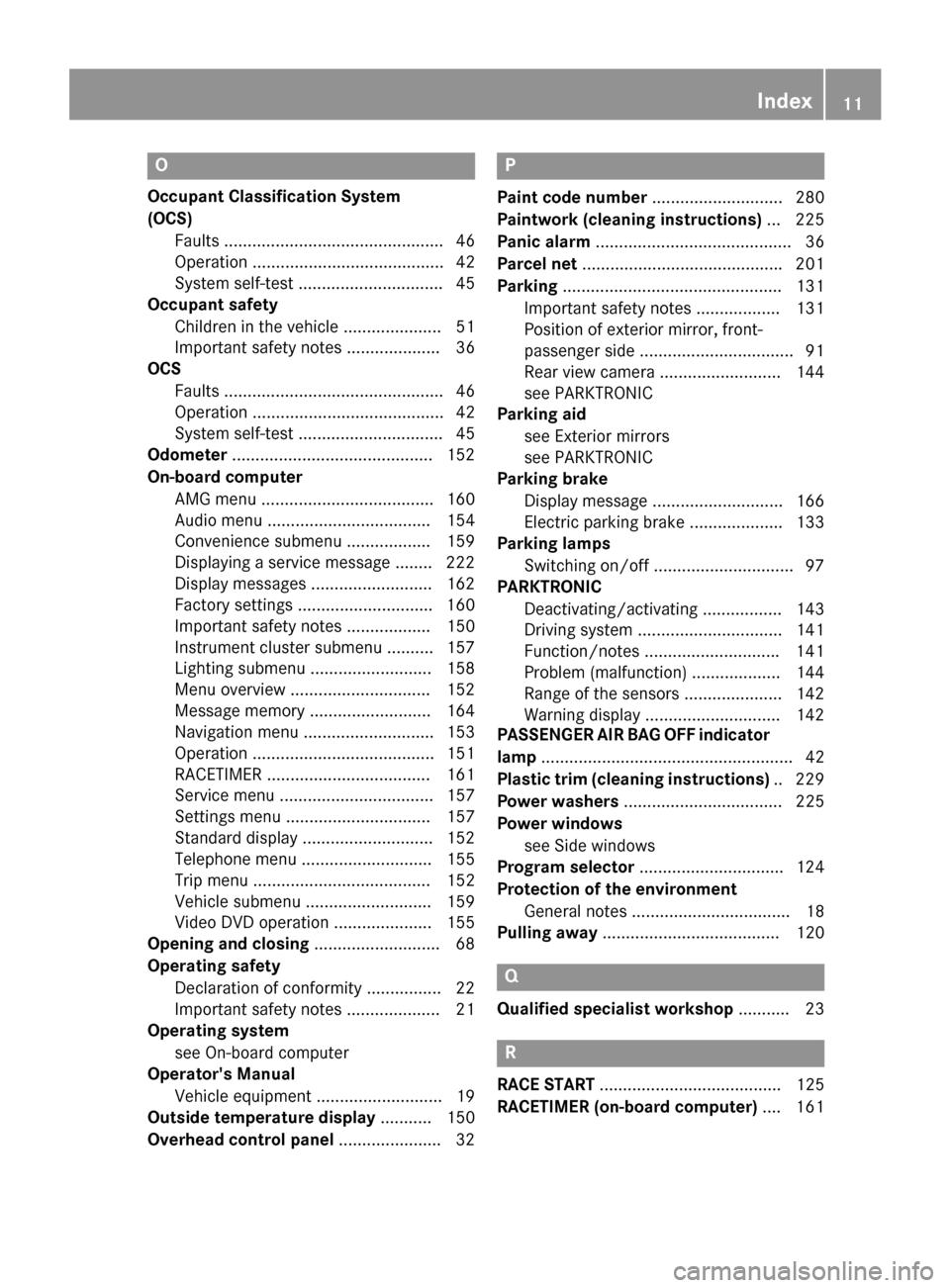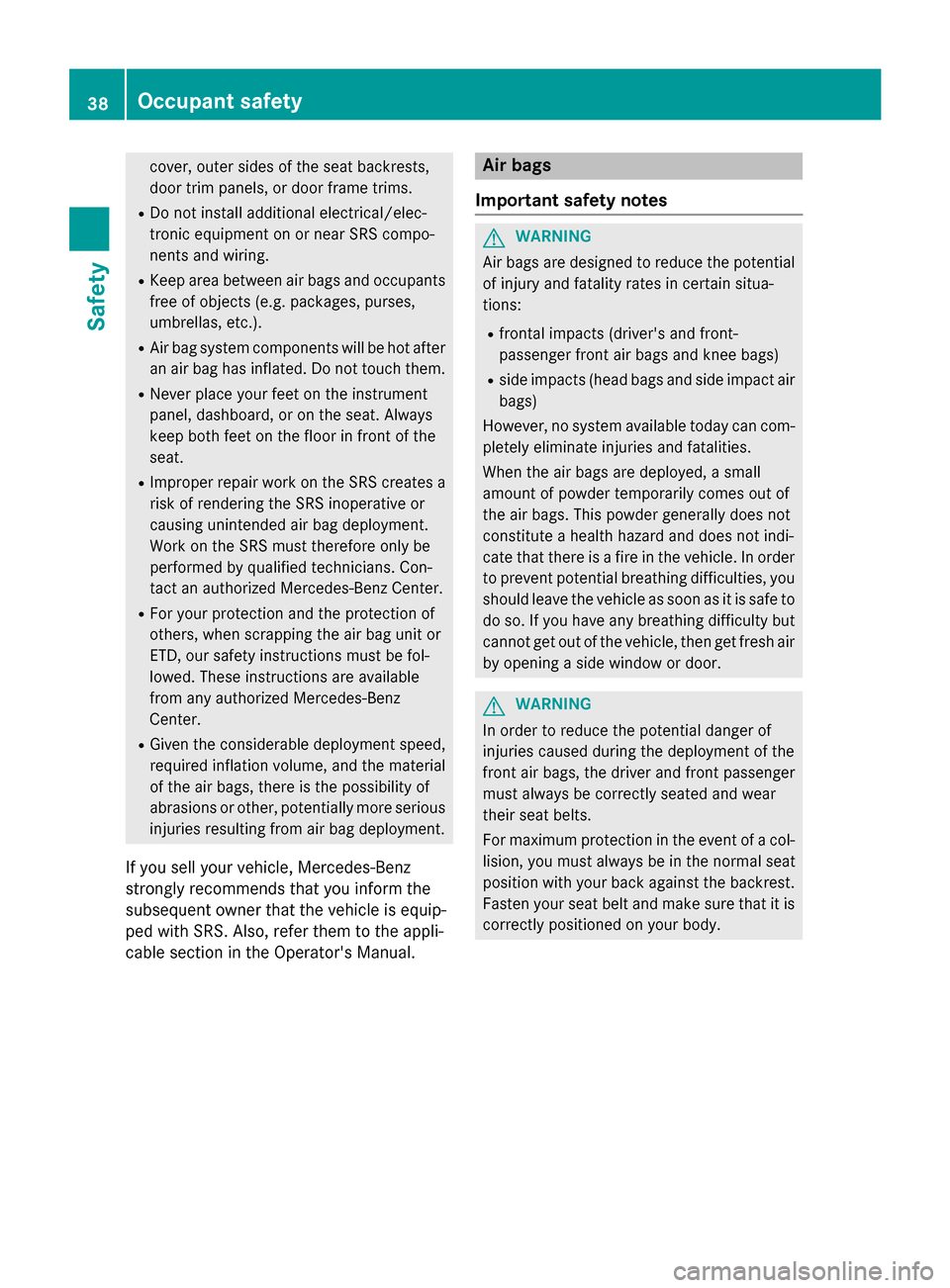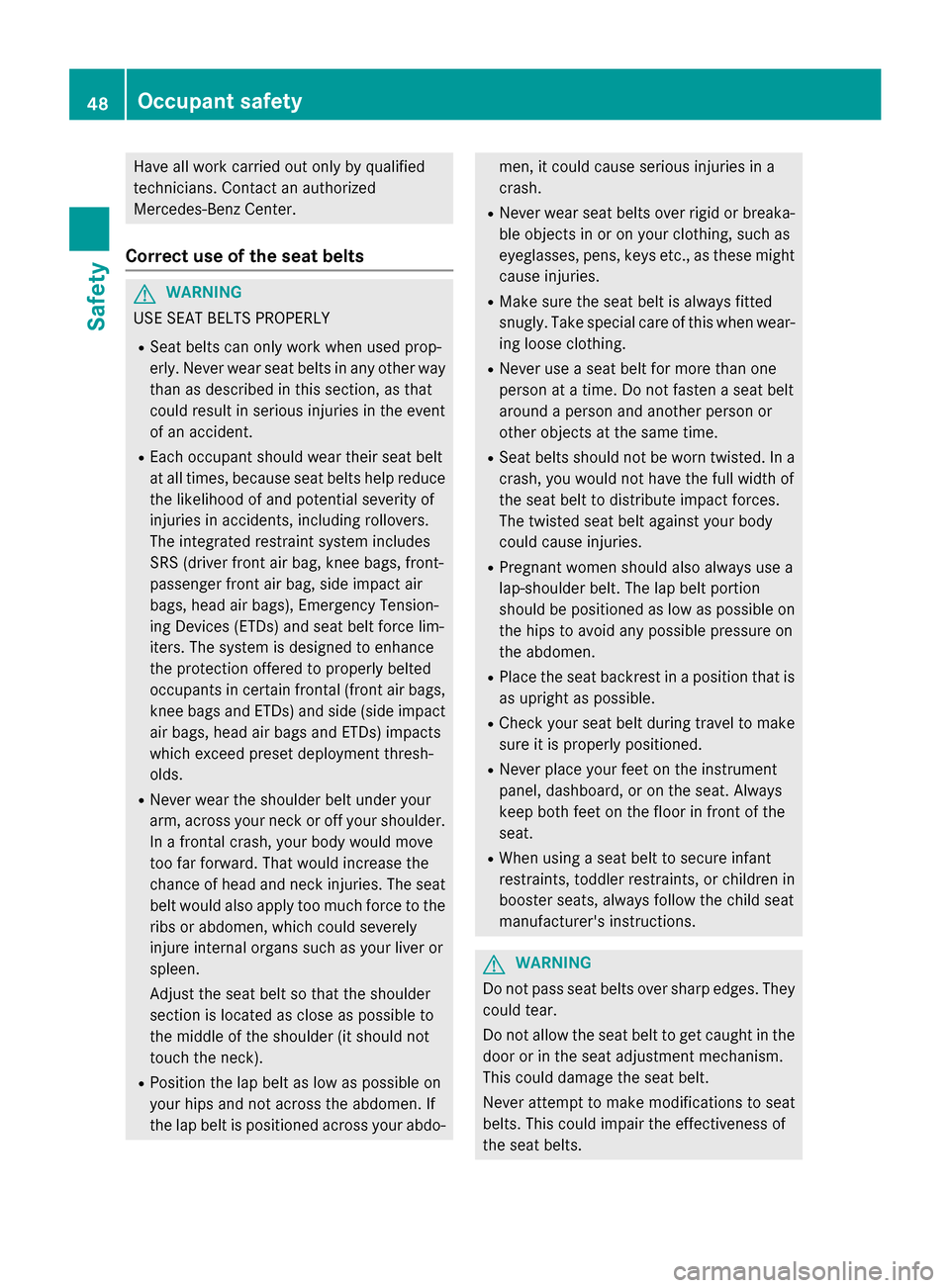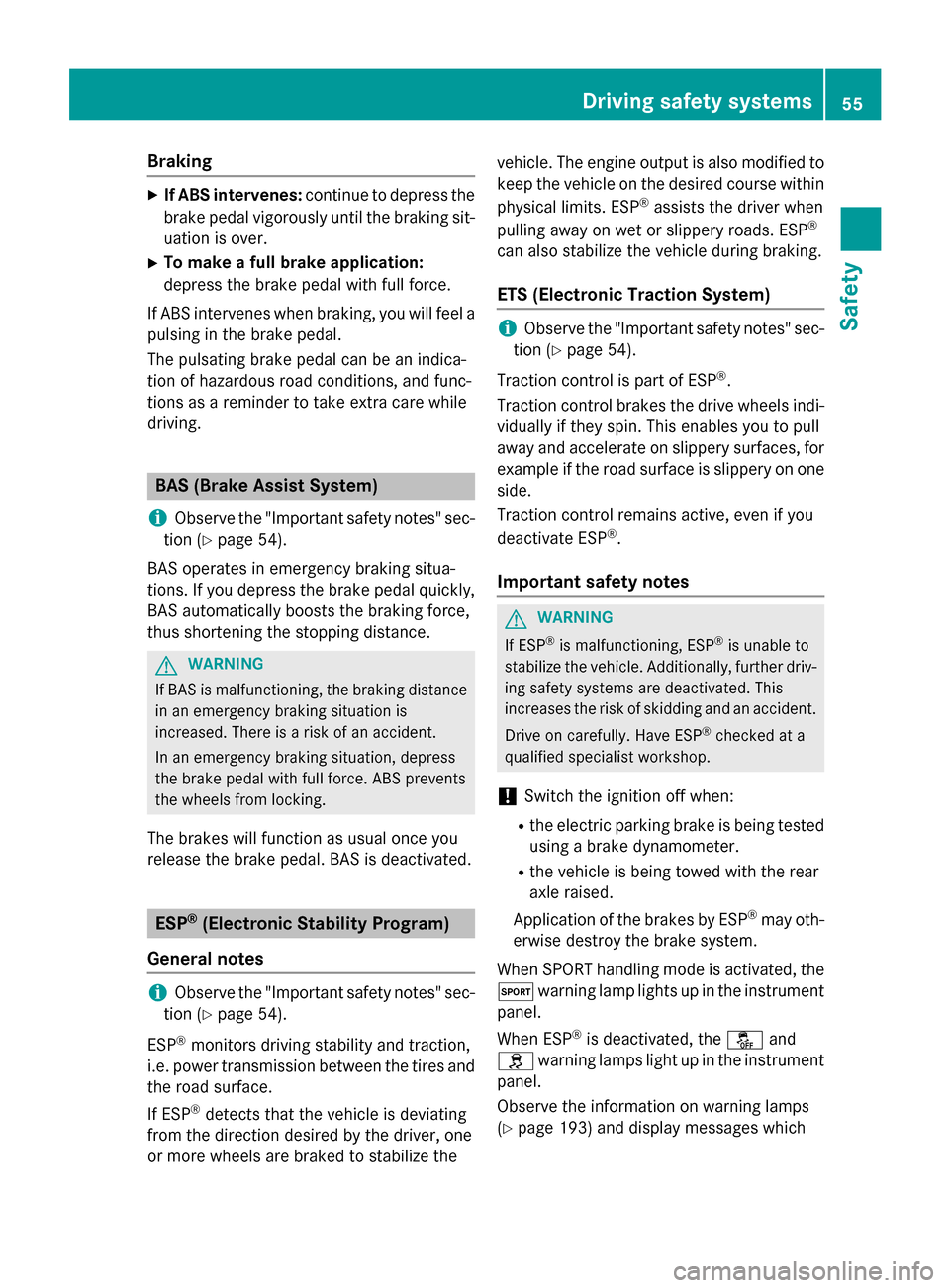2015 MERCEDES-BENZ SLS AMG GT COUPE instrument panel
[x] Cancel search: instrument panelPage 13 of 290

O
Occupant Classification System
(OCS) Faults ............................................... 46
Operation ......................................... 42
System self-test ...............................45
Occupant safety
Children in the vehicle ..................... 51
Important safety notes .................... 36
OCS
Faults ............................................... 46
Operation ......................................... 42
System self-test ...............................45
Odometer ...........................................1 52
On-board computer AMG menu ..................................... 160
Audi omenu ................................... 154
Convenience submenu .................. 159
Displaying aservice message ....... .222
Display messages .......................... 162
Factory settings ............................ .160
Important safety notes .................. 150
Instrument cluster submenu .......... 157
Lighting submenu .......................... 158
Menu overview .............................. 152
Message memory .......................... 164
Navigation menu ............................ 153
Operation ....................................... 151
RACETIMER ................................... 161
Service menu ................................. 157
Settings menu ............................... 157
Standard displa y............................ 152
Telephone menu ............................ 155
Trip menu ...................................... 152
Vehicle submenu ........................... 159
Video DVD operatio n..................... 155
Opening and closing ........................... 68
Operatin gsafety
Declaratio nofconformity ................ 22
Important safety notes .................... 21
Operatin gsystem
see On-board computer
Operator's Manual
Vehicle equipment ........................... 19
Outside temperature display ........... 150
Overhead control panel ......................32 P
Paint code number ............................280
Paintwork (cleaning instructions) ... 225
Pani calarm .......................................... 36
Parce lnet .......................................... .201
Parking ............................................... 131
Important safety notes .................. 131
Position of exterio rmirror, front-
passenger sid e................................. 91
Rea rview camera .......................... 144
see PARKTRONIC
Parking aid
see Exterior mirrors
see PARKTRONIC
Parking brake
Display message ............................ 166
Electric parking brake .................... 133
Parking lamps
Switching on/off .............................. 97
PARKTRONIC
Deactivating/activating ................. 143
Driving system ............................... 141
Function/notes ............................ .141
Problem (malfunction) ................... 144
Range of the sensors ..................... 142
Warning displa y............................. 142
PASSENGER AI RBAG OF Find icator
lamp ...................................................... 42
Plasti ctrim (cleaning instructions) .. 229
Powe rwashers .................................. 225
Powe rwindows
see Sid ewindows
Program selector ............................... 124
Protectio nofthe environment
Genera lnotes .................................. 18
Pulling away ...................................... 120 Q
Qualified specialist workshop ........... 23 R
RAC ESTART ....................................... 125
RACETIMER (on-board computer) .... 161 Index
11
Page 40 of 290

cover
,outer sides of the sea tbackrests,
doo rtrim panels ,ordoorfram etrims.
R Do not install additiona lelectrical/elec-
tronic equipment on or nea rSRS compo-
nents and wiring.
R Kee pareab etween ai rbagsa nd occupants
free of objects (e.g .packages, purses,
umbrellas, etc.).
R Air ba gsystem components will be hot after
an ai rbag hasinflated .Donot touch them.
R Neve rplace your fee tonthe instrument
panel, dashboard, or on the seat. Always
keep both fee tonthe floor in front of the
seat.
R Imprope rrepai rworkont he SRS creates a
ris kofr endering the SRS inoperative or
causing unintende dairba gd eployment.
Work on the SRS mus ttherefore only be
performe dbyqualified technicians. Con-
tact an authorized Mercedes-Benz Center.
R For your protectio nand the protectio nof
others, whe nscrapping the ai rbag uni tor
ETD, ou rsafety instructions mus tbefol-
lowed. These instructions are available
from any authorized Mercedes-Benz
Center.
R Given the considerable deployment speed,
required inflation volume ,and the material
of the ai rbags, there is the possibility of
abrasions or other, potentiall ymore serious
injurie sresulting from ai rbag deployment.
If yo uselly ou rv ehicle ,Mercedes-Benz
strongl yrecommends that yo uinfor mthe
subsequent owner that the vehicle is equip-
ped with SRS. Also ,refe rthem to the appli-
cable section in the Operator's Manual. Ai
rb ags
Important safety notes G
WARNING
Air bags are designe dtoreduce the potential
of injury and fatality rate sincertain situa-
tions:
R fronta limpacts (driver's and front-
passenger front ai rbagsa nd knee bags)
R sid eimpacts (head bags and sid eimpact air
bags)
However, no system available toda ycan com-
pletel yeliminate injurie sand fatalities.
Whe nthe ai rbagsa re deployed, asmall
amount of powder temporaril ycome soutof
the ai rbags. Thi spowder generally doe snot
constitute ahealth hazard and doe snot indi-
cate that there is afire in the vehicle .Inorder
to prevent potentia lbreathing difficulties, you
shoul dlea ve the vehicle as soo nasitiss afeto
do so. If yo uhavea ny breathing difficulty but
cannot get ou tofthe vehicle ,then get fres hair
by opening asidew indow or door. G
WARNING
In order to reduce the potentia ldan ger of
injurie scaused during the deployment of the
front ai rbags, the driver and front passenger
mus talway sbec orrectly seated and wear
thei rseatb elts.
For maximum protectio ninthe event of acol-
lision, yo umusta lway sbeint he norma lseat
position with your back against the backrest.
Fasten your sea tbelta nd make sure that it is
correctly positioned on your body. 38
Occupan
tsafetySafety
Page 50 of 290

Have al
lworkc arried out only by qualified
technicians. Contact an authorized
Mercedes-Benz Center.
Correct use of the sea tbelts G
WARNING
USE SEAT BELTS PROPERLY
R Seat belts can only wor kwhenu sedp rop-
erly. Neve rwearsea tb elts in any other way
than as described in this section, as that
coul dresult in serious injuries in the event
of an accident.
R Each occupant should wea rthei rseatb elt
at al ltimes ,because sea tbelts hel preduce
the likelihood of and potential severity of
injuries in accidents, including rollovers.
The integrated restraint system includes
SRS (driver front ai rbag,k nee bags, front-
passenger front ai rbag,sidei mpact air
bags, hea dairbags) ,Emergency Tension-
ing Device s(ETDs) and sea tbeltf orce lim-
iters .The system is designe dtoenhance
the protection offered to properl ybelted
occupants in certai nfrontal (front ai rbags,
knee bags and ETDs) and sid e(side impact
ai rb ags, hea dairbags and ETDs) impacts
which excee dpreset deployment thresh-
olds.
R Neve rwearthe shoulde rbeltu nde ryour
arm, across your neck or off your shoulder. In af rontal crash ,you rb odyw ould move
too far forward .Tha tw ould increase the
chance of hea dand neck injuries. The seat
bel twould also apply too much force to the
rib sora bdomen, which coul dseverely
injure interna lorgans such as your liver or
spleen.
Adjus tthe sea tbeltsot hat the shoulder
sectio nislocated as clos easpossible to
the middle of the shoulde r(it should not
touch the neck).
R Position the la pbelta slow as possible on
your hip sand not across the abdomen. If
the la pbeltisp ositioned across your abdo- men, it coul
dcause serious injuries in a
crash.
R Neve rwears eatb elts over rigi dorbreaka-
ble objects in or on your clothing, such as
eyeglasses, pens, keys etc., as these might
cause injuries.
R Make sur ethe sea tbeltisa lwaysfitted
snugly .Take specia lcare of this whe nwear-
ing loose clothing.
R Neve ruse aseatb eltf or more than one
person at atime. Do not faste naseatb elt
around aperson and anothe rperson or
other objects at the sam etime.
R Seat belts should not be wor ntwisted. In a
crash ,you would not hav ethe ful lwidth of
the sea tbelttod istribute impact forces.
The twisted sea tbelta gainst your body
coul dcause injuries.
R Pregnant women should also always use a
lap-shoulder belt. The la pbeltp ortion
should be positioned as low as possible on the hip stoavoid any possible pressur eon
the abdomen.
R Place the sea tbackrest in apositio nthat is
as uprigh tasp ossible.
R Check your sea tbeltd uring trave ltomake
sur eitisp roperlypositioned.
R Neve rplace your feet on the instrument
panel, dashboard ,oronthe seat. Always
keep both feet on the floo rinfront of the
seat.
R Whe nusing aseatb elttos ecure infant
restraints, toddler restraints, or children in
booster seats, always follow the chil dseat
manufacturer's instructions. G
WARNING
Do not pass sea tbelts over sharp edges. They
coul dtear.
Do not allow the sea tbelttog et caught in the
doo rorint he seatadjustment mechanism.
Thi scoul dd amaget he sea tbelt.
Neve rattemp ttom ake modifications to seat
belts. Thi scoul dimpai rthe effectivenes sof
the sea tbelts. 48
Occupan
tsafetySafety
Page 57 of 290

Braking
X
If ABS intervenes: continue to depress the
brake peda lvigorously unti lthe braking sit-
uatio niso ver.
X To make afullb rake application:
depress the brake peda lwithf ullf orce.
If ABS intervenes when braking ,you will fee la
pulsing in the brake pedal.
The pulsating brake peda lcan be an indica-
tio nofh azardou sroadc onditions, and func-
tions as areminder to take extra car ewhile
driving. BAS (Brak
eAssis tSystem)
i Observ
ethe "Important safety notes "sec-
tio n(Ypage 54).
BAS operates in emergency braking situa-
tions. If yo udepress the brake peda lquickly,
BAS automaticall yboosts the braking force,
thu sshortening the stopping distance. G
WARNING
If BAS is malfunctioning ,the braking distance
in an emergency braking situatio nis
increased .There is ariskofana ccident.
In an emergency braking situation, depress
the brake peda lwithf ullf orce. ABS prevents
the wheels from locking.
The brakes will functio nasusual once you
release the brake pedal. BAS is deactivated. ESP
®
(Electroni cStability Program)
General notes i
Observ
ethe "Important safety notes "sec-
tio n(Ypage 54).
ESP ®
monitors driving stability and traction,
i.e .power transmission between the tire sand
the roa dsurface.
If ESP ®
detects tha tthe vehicl eisdeviating
from the direction desired by the driver ,one
or more wheels ar ebraked to stabilize the vehicle. The engine outpu
tisa lsom odified to
kee pthe vehicl eonthe desired course within
physical limits .ESP ®
assists the driver when
pulling away on we torslipper yroads. ESP ®
can also stabilize the vehicl eduring braking.
ETS (Electroni cTraction System) i
Observ
ethe "Important safety notes "sec-
tio n(Ypage 54).
Tractio ncontro lispartofE SP®
.
Tractio ncontro lbrakes the drive wheels indi-
viduall yifthey spin. Thi senables yo utopull
away and accelerate on slippery surfaces, for
exampl eifthe roa dsurface is slippery on one
side.
Tractio ncontro lremains active, eve nifyou
deactivate ESP ®
.
Important safety notes G
WARNING
If ESP ®
is malfunctioning ,ESP ®
is unabl eto
stabilize the vehicle. Additionally, further driv- ing safety system sare deactivated. This
increases the ris kofskidding and an accident.
Driv eonc arefully. Hav eESP®
checked at a
qualified specialist workshop.
! Switch the ignition off when:
R the electri cparking brake is being tested
using abrake dynamometer.
R the vehicl eisbeing towed with the rear
axl eraised.
Application of the brakes by ESP ®
ma yoth-
erwis edestro ythe brake system.
Whe nSPOR Thandling mod eisactivated ,the
0074 warning lamp lights up in the instrument
panel.
Whe nESP®
is deactivated ,the 00BB and
0089 warning lamps light up in the instrument
panel.
Observ ethe informatio nonwarning lamps
(Y page 193 )and display messages which Driving safety systems
55Safety Z